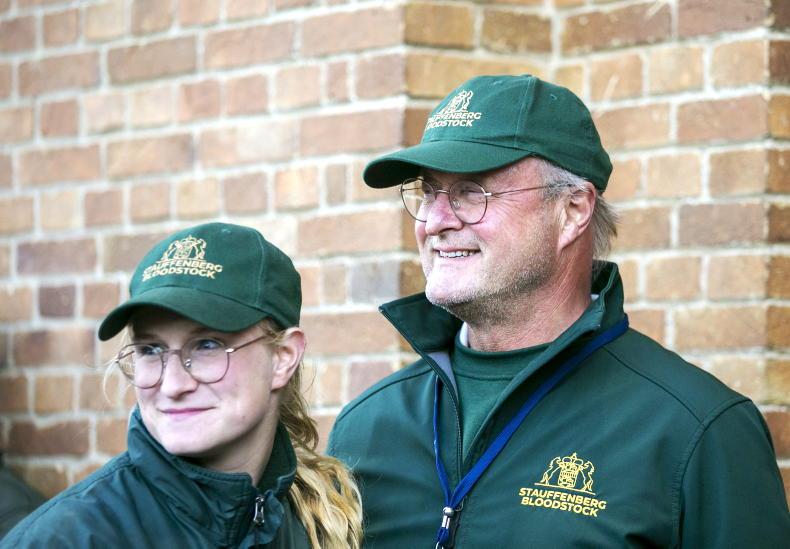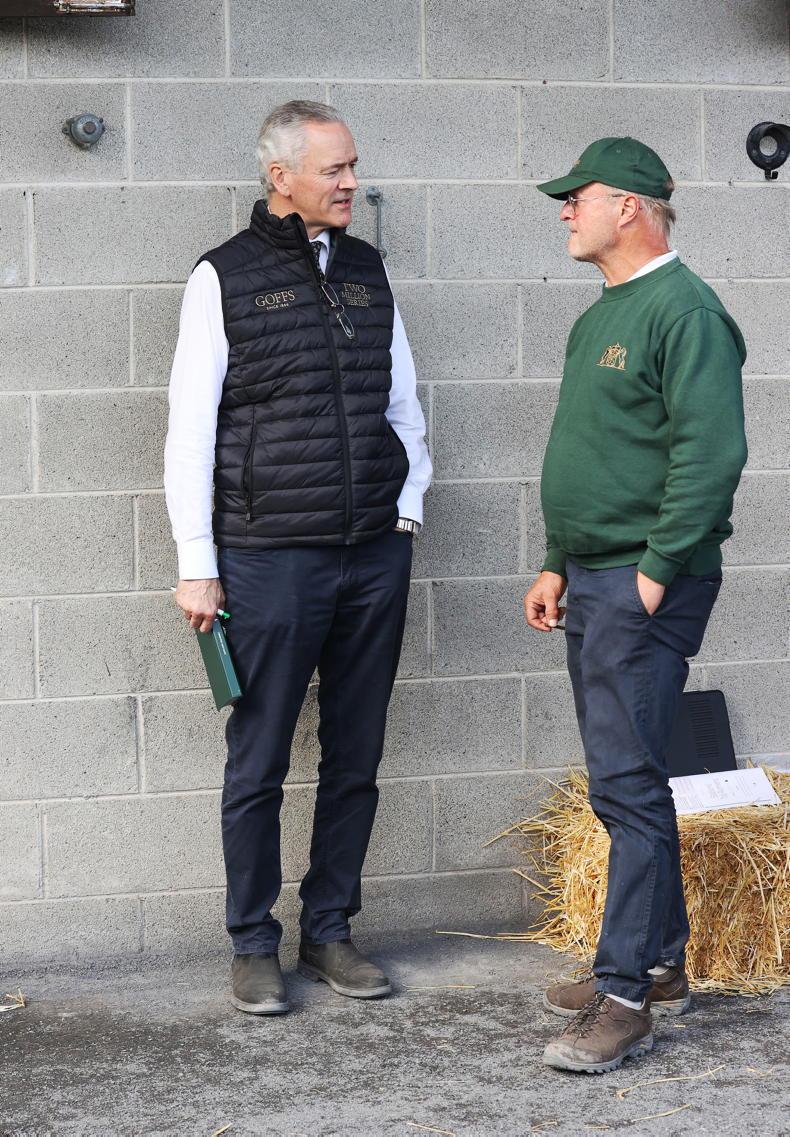“I WOULD like to be remembered as a good person.” This simple statement in many ways sums up Philipp Stauffenberg, and I can attest to the fact that he is a good man.
Working the sales at any complex is a demanding job, and approaching one of the leading participants to ask them to take an hour out and give you time to interview them is akin to putting your hand into the mouth of a lion – it will be bitten off. Not so with Philipp Stauffenberg.
This week he has been busy, putting together a portfolio of foals to reoffer for sale as yearlings, and his seven purchases range in price from €21,000 to €440,000. Certainly, something for everyone in that mix. Yet he still has time to give.
The seven foals are by seven different stallions, four colts and three fillies, and will appeal to the broadest possible international market.
That is important for Philipp. He doesn’t want horses that he breeds or buys to be pigeonholed in any way. What does he look for in a potential purchase, what are key factors in his decision making?
“I am always looking for a racehorse. We want to buy and sell a racehorse, but to survive you have to sometimes compromise on a few things; it should be saleable, and capable of making a profit. Conformation is very, very important.”
Philipp’s dream was to be an Olympic show jumper, and his early career was heading in that direction. Having a family at a young age meant that he had to refocus, and he took to running a stallion station for the production of sport horses. His brother-in-law had a racing background, and so this world was not alien, and over time Philipp’s career path changed and thoroughbreds became his new domain. He worked as an assistant manager for the Ostermann family, and through this work he formed an association and love for Ireland.
Mr Ostermann had horses in training with John Oxx and, during a four-week stay here, prepping two yearlings for sale who were based with Pat Fitzsimons at Oak Lodge, Philipp got to spend time on the Curragh training grounds.
Among the horses in training there was Laurea, later to gain fame as the dam of Lando, the 1993 German Derby winner who rounded out his career as a five-year-old with victory in the Japan Cup.
“I was keen to broaden my horizons and not just focus on Germany. I got into the industry deeper and deeper, and was appointed manager of Gestüt Karlshof, now one of the leading breeders but then it was in its infancy. I built up Karlshof with the owners.
“Then, 30 years ago, I founded my bloodstock agency because I wanted to be a little more independent. I started buying breeding stock for several clients.”
Likeminded
Fate intervened when his now wife Marion was looking for somewhere to board a mare, and a lifetime bond was formed. Philipp and Marion are likeminded, and both had a desire to have their own farm. They took on Schlossgut Itlingen in 1999. With great synergy, this is the 30th anniversary of the agency, and 25th of the farm.
La Concordia, a daughter of Surumu, was purchased in a private transaction and she was to become one of their foundation mares, and she is the grandam of their first Group 1 winner as breeders, Lady Marian.
By Nayef, Lady Marian beat two Irish-trained fillies, Lush Lashes and Katiyra, to win the 2008 Group 1 Prix de l’Opera, and was then sold on to carry the Godolphin colours.
However, a special place in his heart is reserved for the German Oaks winner Que Belle, a daughter of Seattle Dancer. Her sale to Wayne Hughes, “before he had Spendthrift”, created a fiscal window and opportunity to start their own farm.
In Ireland, Philipp had mares with the late Robert Griffin at Loughbrown Stud – “the better mares, as Robert was picky about the mares he would take” – and the rest boarded at the Irish National Stud.
Eimear Mulhern is also someone who played an integral part in the development of Philipp’s business, and she remains a dear friend today. Philipp used to consign with Abbeville, but that was before a change of strategy led to him using his own name as a consignor, and utilising this as a valuable marketing tool.
That move has yielded dividends, and today a draft from Stauffenberg Bloodstock is a must see for discerning buyers.

Polarisation
Providing an overview on the market, Philipp says that polarisation is making it more and more difficult to survive if you are operating in the middle. “There is a fine line between the top and the rest. Years ago, you paid €10,000 for a nomination and sold for an average of €80,000. Now you are paying €30,000 and selling for an average of €60,000.
“This is painful. With the best pedigrees in the hands of a few, catalogues are weakening, and we are fighting for the ones that are put up for sale.”
Philipp has a special bond with thoroughbreds and values them as very sensitive, incredibly intelligent animals, and extremely willing athletes. This view is at the heart of all the work he does with horses, and how he manages his business.
Having a reputation for operating ethically can come at a price, but you build your reputation on success and how you do business.
Success is a continuing story, and the current three-year-olds that Stauffenberg Bloodstock bought as foals tell its own story. “We bought five foals, three are group winners and are Group 1 horses”. That is something to shout about.
“We have created a niche, and people know it’s all straightforward – so they come back and buy. Obviously, it’s not easy, but I just want to follow a straight line.
“You have to continue to deliver, and over many years we have made friends, contacts. People accept how we operate. Overall, we are a small operation, pinhooking something like four to eight foals. It’s the same with the breeding side.”

Favourites
Philipp has any number of favourite horses, but one that has to be high on his list is last year’s Derby winner Fantastic Moon, set to contest the Japan Cup before he heads to stud.
“There is something very special about breeding our first German Derby winner. Even better is that he traces back to one of our foundation mares, Fraulein Tobin.”
One perception that Philipp is keen to clear up is that he is not a very rich man who just deals in expensive horses. “I get up every day at 5.30am when the alarm goes off, and often don’t get to bed until midnight. Last week, in the four days before I came to Goffs, I had just six hours sleep overall.
“I operate a lot on my own, the work on the stud is very much hands-on. The foals we pinhook are for a syndicate, and there is a lot of communicating with members, which is also something I enjoy.”
Survival in the business is going to be important in the years ahead, as Philipp believes that the business is becoming more divided. He has aspirations, “always trying to improve” and “breeding and buying good horses” among them.
He admits to having no crystal ball when asked how he feels the market will go. “Look at this year – who would have predicted what is happening?”
Challenges
The future is not all rosy in his view, and there are challenges. “A major problem is to get young people involved, and that was one of the reasons why I was so happy to come to Ireland and speak on the panel that the Next Generation in the ITBA organised.
“We have to encourage young people in any way we can. This week at Goffs I have young people from France and Germany shadowing me.
“Another big problem is to address how we are seen. Our industry can be brutal at times, and it can be very hard on horses.
“Take the foal sales, walking young horses up and down, with maybe 100 shows a day. This is tough and we need to find ways to address such issues.
“As a business we need to step back and reflect, as we have a responsibility to the horses. It is imperative that we can show people, who are increasingly urbanised, that we are taking care of the horses.”
NEXT WEEK: Read an update to Philipp’s success in breeding and pinhooking in Breeding Insights, and more details about how he got started.